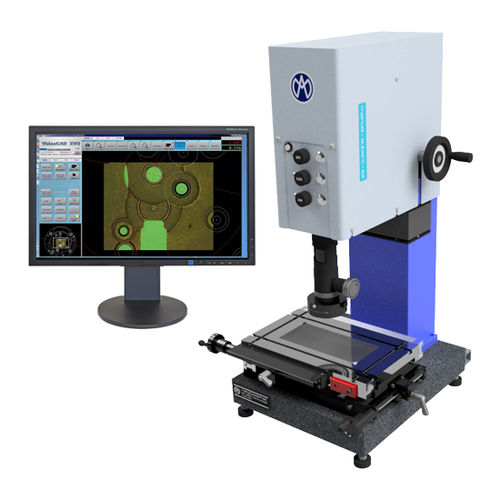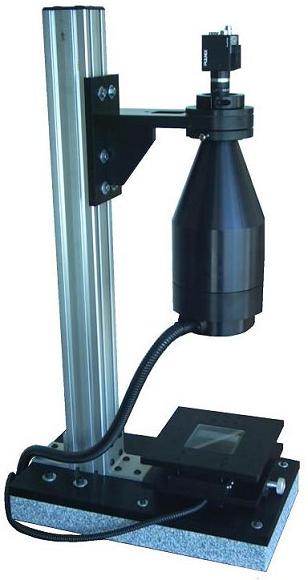The science behind optical measurement: key principles
The science behind optical measurement: key principles
Blog Article
Understanding Exactly How Optical Measurement Systems Enhance Top Quality Control Processes
When you're looking to boost quality assurance processes, recognizing optical dimension systems is vital. These modern technologies offer specific, non-contact measurements that can transform your examination techniques. By leveraging innovative methods, you can improve procedures and reduce mistakes. But how precisely do these systems incorporate into existing operations, and what advantages do they bring? Allow's explore the crucial facets that make optical measurement a game-changer in quality monitoring.

The Principles of Optical Measurement Solutions
Optical measurement systems play a crucial duty in guaranteeing item quality across different markets. These systems utilize light-based technologies to gather accurate data regarding physical characteristics, such as measurements, surface coating, and shade. By using lasers, cameras, and sensors, you can achieve non-contact dimensions that reduce the threat of destructive fragile products.
Comprehending the basics of these systems is basic for efficient quality assurance. They operate on concepts like diffraction, refraction, and reflection, enabling you to evaluate numerous products and forms. The precision and speed of optical dimensions make it possible for real-time monitoring, which helps you recognize flaws early in the production procedure.
In addition, these systems can be incorporated with software program for enhanced information evaluation, creating a detailed quality monitoring method. By leveraging optical dimension systems, you not just enhance performance however additionally ensure your items meet rigid high quality standards, eventually boosting customer fulfillment.
Kinds of Optical Dimension Technologies
Numerous sorts of optical dimension modern technologies are offered, each made to satisfy certain needs in top quality control. You might come across laser triangulation, which gauges distance by evaluating the angle of a shown laser beam of light. This modern technology is optimal for recording precise dimensions in 3D space.
One more alternative is structured light, where you project a series of light patterns onto a surface to produce an in-depth 3D version. This approach functions well for intricate geometries.
After that there's interferometry, which can spot minute modifications in surface profiles by evaluating the interference patterns of light waves. This is especially helpful for applications requiring nanometer precision.
You may also consider optical coherence tomography, which provides high-resolution photos of inner attributes without harming the item. Each innovation serves various demands, so choosing the ideal one is necessary for attaining best quality control results.
Secret Advantages of Optical Measurement in Quality Assurance
When it comes to top quality control, leveraging optical dimension innovations can considerably improve accuracy and performance. These systems enable you to capture detailed dimensions swiftly, decreasing the moment required for inspections. You'll see that optical dimensions can identify also the smallest flaws that may go unnoticed with typical techniques, ensuring item consistency.
In addition, using optical dimension systems typically leads to minimized waste and rework, as you catch concerns early in the production procedure. You'll also appreciate the non-contact nature of several optical techniques, which decreases damage to fragile components during evaluation. This adaptability permits a more comprehensive range of applications across various products.
With real-time information collection, you can make informed decisions promptly, streamlining your high quality guarantee procedures (optical measurement). Ultimately, integrating optical dimension right into your quality assurance strategy not only improves performance yet likewise boosts consumer complete satisfaction by supplying higher-quality items continually
Just How Optical Dimension Equipment Improve Precision and Accuracy
Optical dimension systems enhance precision and accuracy by boosting dimension resolution, permitting you to spot even the smallest variations. With real-time data analysis, you can make instant changes and choices, guaranteeing your procedures remain on track. This combination not only improves product quality but also streamlines your quality control efforts.
Enhanced Dimension Resolution
By leveraging innovative modern technologies, optical dimension systems substantially improve measurement resolution, resulting in improved precision and precision in quality assurance. These systems use high-resolution cams and sophisticated algorithms to catch minute details that traditional approaches commonly miss. You'll notice a substantial difference in the quality of dimensions, allowing you to recognize even the slightest inconsistencies from specs. This enhanced resolution aids get rid of guesswork, offering you with data that's both workable and reliable. Therefore, you can make more enlightened decisions and keep tighter tolerances in your processes. Ultimately, boosted measurement resolution not only boosts item quality yet also maximizes resource usage, ensuring that you satisfy consumer expectations constantly.
Real-Time Information Evaluation
Although standard dimension systems commonly count on postponed data processing, real-time data analysis in optical dimension systems reinvents the means you monitor top quality. By supplying immediate feedback, these systems allow you to find discrepancies and disparities as they take place, permitting speedy corrective actions. You'll experience enhanced precision considering that you can instantaneously compare dimensions against predefined standards. This gets rid of guesswork and reduces the danger of issues slipping via. Furthermore, real-time information helps you gather important understandings with time, fine-tuning your quality assurance processes. With this sophisticated technology, you'll boost both precision and efficiency, making sure that your items constantly satisfy high standards. Welcome real-time analysis, and see your quality assurance efforts rise to brand-new heights.
Integrating Optical Measurement Into Existing Quality Assurance Processes
Incorporating optical measurement into your existing quality assurance procedures can considerably enhance accuracy and effectiveness. By including optical dimension systems, you can improve data collection, lowering human mistake while increasing the speed of assessments. Beginning by recognizing bottom lines in your assembly line where optical measurements will certainly supply one of the most worth.
Following, educate your group on the new innovation, ensuring they recognize just how to make use of the systems efficiently. This training will help them interpret results rapidly and precisely.
You must likewise establish a procedure for integrating optical data into your existing quality management software. This assimilation permits real-time analytics and coverage, improving decision-making.
Consistently examine the data and responses from your group to identify any type of locations for improvement. With these steps, you'll not just enhance your quality assurance procedures yet also promote a society of continual renovation within your company.
Situation Studies: Successful Execution of Optical Dimension Systems
In this section, you'll discover how optical measurement systems have actually transformed quality assurance in industries such as aerospace and automotive look at this website production - optical measurement systems. You'll see real-world instances of exactly how these technologies improved precision and effectiveness. These situation researches highlight the concrete advantages of integrating optical systems into manufacturing procedures
Aerospace Sector Applications
As the aerospace sector encounters boosting needs for precision and efficiency, companies are transforming to optical dimension systems to improve their high quality control processes. A leading airplane supplier incorporated optical measurement technology to inspect generator blades, minimizing assessment time by 50% while enhancing precision.
Automotive Manufacturing Success
Optical dimension systems have likewise made significant strides in the automobile manufacturing industry, where precision is crucial to vehicle efficiency and security. By executing these sophisticated systems, manufacturers like BMW and Ford have actually drastically boosted their quality assurance processes. For example, BMW integrated optical dimension for body setting up, guaranteeing components fit perfectly, which minimized rework and enhanced manufacturing effectiveness. Ford adopted 3D scanning methods to discover dimensional mistakes in engine components, resulting in less flaws and improved reliability. These study demonstrate exactly how optical dimension systems encourage you to attain tighter tolerances, minimize waste, and elevate general product top quality. Accepting these technologies can cause substantial affordable advantages in today's fast-paced auto sector.
Future Patterns in Optical Dimension and Quality Assurance
While innovations in innovation proceed to improve the manufacturing landscape, the future of optical measurement and quality assurance looks encouraging - optical measurement system. You'll see a substantial change towards automation and AI combination, enabling systems to evaluate information in real-time. This suggests quicker decision-making and decreased human mistake, inevitably improving item top quality
Moreover, as 3D imaging technology boosts, you'll take advantage of more accurate dimensions of intricate geometries, making it easier to maintain limited tolerances. The rise of cloud-based solutions will also allow you to access data remotely, helping with partnership and enhancing procedures.
Furthermore, sustainability will play an important function in future advancements. Anticipate optical measurement systems to concentrate on power performance and waste decrease, lining up with global environmental goals. By embracing these trends, you can assure your quality assurance processes stay sophisticated, helping your organization thrive in a significantly affordable market.
Often Asked Concerns
What Industries Benefit Most From Optical Dimension Solutions?
You'll find sectors such as manufacturing, aerospace, and automotive advantage most from optical dimension systems. These industries rely on precise dimensions for quality control, ensuring items fulfill rigorous standards and boosting general operational performance.
Exactly how Do I Pick the Right Optical Measurement System?
To choose the right optical dimension system, evaluate your details requirements, consider the kind of measurements you need, assess the system's accuracy, and guarantee it fits your spending plan and operational needs.
What Prevail Obstacles in Executing Optical Dimension Systems?
You'll deal with challenges like integration with existing systems, guaranteeing precise calibration, educating personnel internet efficiently, and taking care of costs. Recognizing these hurdles early assists you create methods to conquer them and effectively carry out optical measurement systems.

Are There Training Resources Available for Optical Measurement Technologies?
Yes, there're various link training resources offered for optical measurement innovations. You can discover on the internet programs, webinars, and workshops used by market professionals or companies. These sources can assist you efficiently implement and utilize these advanced systems.
How Do Optical Measurement Systems Contrast to Traditional Measurement Approaches?
Optical dimension systems supply better accuracy and speed compared to conventional techniques. They decrease human error, enable non-contact dimensions, and provide real-time data evaluation, making them extra reliable for various applications in quality control.
Final thought

Optical dimension systems boost accuracy and precision by improving measurement resolution, enabling you to identify also the tiniest variations.By leveraging advanced technologies, optical measurement systems significantly improve measurement resolution, leading to improved accuracy and precision in high quality control.Although standard dimension systems often rely on delayed information handling, real-time information evaluation in optical dimension systems reinvents the way you keep track of high quality.As the aerospace market faces enhancing demands for precision and efficiency, firms are transforming to optical dimension systems to improve their high quality control processes. How Do Optical Dimension Systems Contrast to Typical Dimension Methods?
Report this page